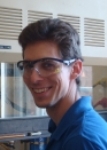Org. Synth. 2010, 87, 59
DOI: 10.15227/orgsyn.087.0059
PREPARATION OF (S)-3,3'-BIS-MORPHOLINOMETHYL-5,5',6,6',7,7',8,8'-OCTAHYDRO-1,1'-BI-2-NAPHTHOL
Submitted by Mark Turlington and Lin Pu
1.
Checked by Kyle L. Kimmel and Jonathan A. Ellman.
1. Procedure
Paraformaldehyde (30 g, 1.0 mol) (Note 1) is added to a 250-mL round-bottomed flask, open to air, which is cooled with an ice bath. With vigorous stirring, morpholine (88 mL, 1.0 mol) (Note 2) is added dropwise over 1 h via addition funnel. The addition must be performed slowly with cooling because the reaction is exothermic. After the addition is complete, the ice bath is removed (Note 3), and with stirring, the solution is allowed to warm to room temperature over 2 h (Note 4). The round-bottomed flask is fitted with a reflux condenser and the reaction mixture is heated at 60 ºC in an oil bath for 10 h (Note 5). A clear and viscous solution (107 mL) containing morpholinomethanol as well as other species is formed. The product is verified by 1H and 13C NMR analyses and the concentration of morpholinomethanol in the solution is determined to be 2.3 M (Notes 6-8).
To a 250-mL, 3-necked, round-bottomed flask is added (S)-5,5',6,6',7,7',8,8'-octahydro-1,1'-bi-2-naphthol [(S)-H8BINOL, 5.0 g, 17.0 mmol] (Note 9). One neck of the flask is fitted with a reflux condenser which is fitted with a vacuum adaptor connected to a Schlenk line. The second neck of the flask is fitted with a glass stopper. The third neck is fitted with a thermometer to monitor the internal temperature. The flask is then evacuated (5 × 10-3 mmHg) and subsequently refilled with nitrogen (Note 10). This process is conducted three times. Maintaining a positive pressure of nitrogen, the glass stopper is then replaced with a rubber septum. To the flask is added 1,4-dioxane (30 mL) via syringe (Note 11).
The solution containing morpholinomethanol (Note 12) is bubbled with nitrogen for 30 min to remove any dissolved oxygen and then is transferred via cannula through the septum to the reaction flask containing (S)-H8BINOL (Note 13). While maintaining a positive pressure of nitrogen, the septum is replaced with a glass stopper. The reaction flask is then heated in an oil bath for 18 h to maintain the internal temperature at 60 °C. Thin layer chromatography (TLC) shows complete consumption of the starting material, (S)-H8BINOL (Note 14).
After allowing the flask to cool to room temperature, the reaction mixture is diluted with ethyl acetate (150 mL) in a 500-mL separatory funnel (Note 15). The organic layer is washed with a saturated NaHCO3 solution (3 × 100 mL) and distilled water (2 × 100 mL). The organic layer is then dried with sodium sulfate (20 g) (Note 16), filtered, and transferred to a 1-L round-bottomed flask. The solvent is removed via rotary evaporation (30 ºC, 10 mmHg) to yield a white solid.
The compound is purified via crystallization in ethanol. Hot ethanol (600 mL) is added to the 1-L round-bottomed flask to dissolve the product (Note 17). The solution is cooled to room temperature (Note 18), and then further cooled at -18 °C in a laboratory freezer for 44 h. Vacuum filtration (Note 19) with a Büchner funnel gives 7.48 g of (S)-1 (90% yield) as white, fluffy, needle-like crystals (Notes 20-22). (S)-1 is obtained with >99% ee and 99% purity as demonstrated by HPLC analysis (Note 23).
2. Notes
1.
Paraformaldehyde, powder, (95%) was used as purchased from Sigma-Aldrich.
2.
Morpholine, A.C.S. reagent, (≥99%) was used as purchased from Sigma-Aldrich.
3.
After removal of the ice bath, the solution was viscous, preventing stirring. A spatula was used to free the magnetic stir-bar, and stirring was resumed.
4.
During this time, the round-bottomed flask became warm to the touch as the paraformaldehyde fully dissolved to give a clear solution.
5.
The reaction can be allowed to proceed overnight without decomposition of the product.
6.
The solution containing morpholinomethanol is also known to contain dimorpholinomethane, as well as other unidentified species.
2 The
1H and
13C NMR spectra clearly show both species present in solution. The analytical data corresponding to morpholinomethanol are as follows:
1H NMR (300 MHz CDCl
3) δ: 2.02 (s, 1 H), 2.64-2.68 (m, 4 H), 3.67-3.70 (m, 4 H), 4.11 (s, 2 H);
13C NMR (300 MHz CDCl
3) δ: 49.3, 66.5, 86.9. The peaks were assigned based on known chemical shifts for morpholinomethanol.
2 Dimorpholinomethane, which is also present in solution, gives the following analytical data:
1H NMR (300 MHz, CDCl
3) δ: 2.47 (t,
J = 4.65 Hz , 8 H), 2.88 (s, 2 H), 3.67-3.70 (m, 8 H);
13C NMR (300 MHz, CDCl
3) δ: 51.6, 66.5, 81.2. These peaks were assigned based on known chemical shifts for dimorpholinomethane.
2 Other unknown species are present, as there are additional peaks in both the
1H NMR and
13C NMR spectra. These include:
1H NMR (300 MHz, CDCl
3) δ: 4.23, 4.74, 4.80-4.93;
13C NMR (300 MHz, CDCl
3) δ: 48.6, 85.8, 86.0, 86.2, 87.8, 89.6, 91.4. The unassigned peaks in the
13C NMR spectra are much smaller than the assigned peaks. We propose that dimorpholinomethyl ether may be one of the unknown species.
7.
The concentrations of morpholinomethanol and dimorpholinomethane were determined to be approximately 2.3 M and 2.9 M, respectively. These concentrations were determined by using
1H NMR spectroscopy with an added internal standard (
p-chlorobenzaldehyde).
8.
Morpholinomethanol becomes unreactive after an undetermined amount of time, though it remains reactive for at least one to two months. It is advisable to prepare fresh morpholinomethanol. No difference in the
1H NMR spectra is detectable for reactive verse unreactive morpholinomethanol.
9.
Both (
S)-(-)-5,5',6,6',7,7',8,8'-octahydro-1,1'-bi-2-naphthol and (
R)-(+)-5,5',6,6',7,7',8,8'-octahydro-1,1'-bi-2-naphthol can be purchased from TCI America. Alternatively, they can be prepared from BINOL.
310.
BINOL and its derivatives are susceptible to oxidation.
11.
1,4-Dioxane (Certified A.C.S. grade) was used as purchased from Fisher Chemicals and passed through a column of activated alumina under nitrogen pressure immediately prior to use.
12.
A large excess of the morpholinomethanol solution was necessary to obtain a good yield. The yield was diminished when smaller amounts of the morpholinomethanol solution were used.
13.
To bubble the morpholinomethanol solution with nitrogen gas, a needle connected to a nitrogen line was inserted through the rubber septum of the flask. A vent needle was also inserted through the septum. The nitrogen pressure was adjusted so that bubbles were clearly seen in the liquid.
14.
Aluminum-backed silica gel 60 F
254 TLC plates purchased from EMD Chemicals Inc. were used. Hexanes/ethyl acetate (2:1) was used as the eluent and the plate was visualized with ultraviolet light. The product moves only slightly off the baseline (R
f = 0.04), while H
8BINOL has an R
f = 0.28.
15.
Ethyl acetate (Certified A.C.S. grade) was used as purchased from Fisher Chemicals.
16.
Sodium sulfate, anhydrous, was purchased from Fisher Chemicals.
17.
Ethanol, absolute, 200 proof, Acros Organics, was used as purchased from Fisher Chemicals. Because the entire solid does not readily dissolve even with increasing amounts of ethanol, the flask was fitted with a reflux condenser and placed under a nitrogen atmosphere. The solution was then stirred at 78 ºC in an oil bath for approximately 1 h. During this time, the solid completely dissolved.
18.
A small amount of precipitation occurs quickly as the flask cools to room temperature.
19.
The product was rinsed with 25 mL of cold ethanol and allowed to air dry over the vacuum filter for 15 min.
20.
On half scale, 2 crops of crystals were obtained, with a total yield of 3.48 g (83%). Both crops of crystals were obtained with >99% ee and 99% purity, as determined by HPLC analysis. The addition of a few seed crystals was required to initiate the second crystallization.
21.
In order to remove trace ethanol from the catalyst, it was necessary to follow the drying procedure, wherein the compound (1.43 g) is dissolved in
THF (20 mL) and evacuated with stirring under high vacuum (5 × 10
-3 mmHg) at 40 °C for 2 h. A more detailed description of the drying procedure can be found in the following procedure.
22.
The product, (
S)-3,3'-bis-morpholinomethyl-5,5',6,6',7,7',8,8'-octahydro-1,1'-bi-2-naphthol, gives the following analytical data after following the drying procedure described in
Note 21: [a]
D20 -15.4 (
c 1.09, CHCl
3) (Notes
24 and
25);
1H NMR
pdf (400 MHz, CDCl
3) δ: 1.61-1.73 (m, 8 H), 2.12-2.18 (m, 2 H), 2.29-2.35 (m, 2 H), 2.53 (bs, 8 H), 2.70 (bs, 4 H), 3.57 (d, 2 H,
J = 13.2 Hz), 3.66 (s, 8 H), 3.78 (d, 2 H,
J = 13.2 Hz), 6.71 (s, 2 H), 10.36 (s, 2 H);
13C NMR
pdf (125 MHz CDCl
3) δ: 23.2, 23.3, 27.0, 29.3, 53.0, 62.0, 66.7, 117.8, 124.0, 127.6, 128.8, 136.0, 152.1; Anal. calcd. for C
30H
40N
2O
4: C, 73.14; H, 8.18; N, 5.69; found: C, 72.75; H, 8.22; N, 5.63.
23.
An Agilent 1110 Series Instrument with a multiple wavelength detector was used for HPLC analysis. A Daicel Chiralcel OD column was eluted with hexanes:isopropanol:triethylamine (95:5:0.1) at 1.0 mL/min. Buffering with triethylamine was required to elute the product, which contains an amine and can stick to the column. The retention times of the
R- and
S-enantiomers were determined to be as follows: t
(R)-1 = 15.1 min. and t
(S)-1 = 31.1 min.
24.
The specific rotation was measured on a Perkin-Elmer 241 polarimeter with a sodium lamp (589 nm, D line) using a 1 dm, 2 mL quartz sample cell.
25.
The specific rotation value is corrected from the value we previously reported.
7-9
Handling and Disposal of Hazardous Chemicals
The procedures in this article are intended for use only by persons with prior training in experimental organic chemistry. All hazardous materials should be handled using the standard procedures for work with chemicals described in references such as "Prudent Practices in the Laboratory" (The National Academies Press, Washington, D.C., 2011 www.nap.edu). All chemical waste should be disposed of in accordance with local regulations. For general guidelines for the management of chemical waste, see Chapter 8 of Prudent Practices.
These procedures must be conducted at one's own risk. Organic Syntheses, Inc., its Editors, and its Board of Directors do not warrant or guarantee the safety of individuals using these procedures and hereby disclaim any liability for any injuries or damages claimed to have resulted from or related in any way to the procedures herein.
3. Discussion
1,1'-Bi-2-naphthol (BINOL) and its derivatives have been extensively used for asymmetric catalysis.
4 Derivatives of the partially hydrogenated BINOL, (H
8BINOL), have also been studied and in many instances have shown improved enantioselectivity over BINOL.
5 This increased stereocontrol is attributed to the increased dihedral angle between the two aromatic rings due to the increased steric interactions of the partially hydrogenated aryl rings. Thus, derivatives of H
8BINOL are interesting ligands for asymmetric catalysis.
Furthermore, BINOL derivatives containing both Lewis acidic and Lewis basic functionalities have generated interest as bifunctional chiral catalysts, and have been shown to exhibit good enantioselectivity in an array of reactions.
6 These catalysts are attractive as the bifunctional character enables the activation of both a nucleophile and an electrophile in a chiral environment.
The title compound, (
S)-
1, represents such a bifunctional chiral catalyst. The dihydroxy groups yield Lewis acidic centers upon reaction with a metal species, and the nitrogen atoms of the morpholinomethyl groups provide two Lewis basic sites. In addition to its bifunctional character, our catalyst also utilizes the reported advantages of the increased steric bulk of the partially hydrogenated naphthyl rings. Recently, our group has demonstrated the utility of the title compound in the asymmetric synthesis of two widely useful intermediates in organic synthesis, specifically chiral a-substituted benzyl alcohols and chiral propargylic alcohols.
7-9In the presence of catalyst (
S)-
1 (10 mol%), diphenyl zinc addition to aldehydes affords chiral a-substituted benzyl alcohols at room temperature and requires no additives, as shown in Scheme 1.
8-10 The catalyst is widely applicable, as high enantioselectivities are obtained for linear, α-branched, and ß-branched aliphatic aldehydes, as well as for α,ß-unsaturated aldehydes.
8,9 The ability to control the diphenyl zinc addition to linear aliphatic aldehydes is notable, as this is unique to our catalyst.
para-Substituted aromatic aldehydes also give high chiral induction, while
ortho- and
meta-substituted benzaldehydes show moderate enantioselectivity.
8,9 In addition, (
S)-
1 can also catalyze the addition of functionalized diarylzincs, generated in situ from aryl iodides, to react with a variety of aldehydes with high enantioselectivity.
11Scheme 1. Asymmetric diaryl zinc addition to aldehydes.
8,9,11
Our lab has also demonstrated the use of (
S)-
1 in the asymmetric alkyne addition to aldehydes, as illustrated in Scheme 2. In the presence of (
S)-
1 (10 mol%), ZnEt
2, and Ti(O
iPr)
4, chiral propargylic alcohols are obtained at room temperature in 4 h. The catalysis proves especially useful for
ortho-substituted benzaldehydes, affording high enantioselectivities.
7,9,12 In previous studies, H
8BINOL was unable to yield high enantioselectivities in this reaction for
ortho-substituted benzaldehydes.
5k The title compound also demonstrated good control of enantioselectivity for
meta- and
para-substituted benzaldehydes.
7,9Scheme 2. Asymmetric alkyne addition to aldehydes.
7,9
The synthetic procedure of (
S)-
1 described in this paper provides a convenient route to this functionalized H
8BINOL ligand. Unlike other 3,3'-Lewis base substituted BINOL ligands that normally require six or seven synthetic steps from BINOL,
13 the synthesis of (
S)-
1 involves only one step from the commercially available (
S)-H
8BINOL.
References
Appendix
Chemical Abstracts Nomenclature (Collective Index Number);
(Registry Number)
Paraformaldehyde; (30525-89-4)
Morpholine; (110-91-8)
Morpholinomethanol: 4-Morpholinemethanol; (4432-43-3)
(S)-5,5',6,6',7,7',8,8'-Octahydro-1,1'-bi-2-naphthol [(S)-H8BINOL]: [1,1'-Binaphthalene]-2,2'-diol, 5,5',6,6',7,7',8,8'-octahydro-, (1S)-; (65355-00-2)
(S)-3,3'-Bis-morpholinomethyl-5,5',6,6',7,7',8,8'-octahydro-1,1'-bi-2-naphthol: [1,1'-Binaphthalene]-2,2'-diol, 5,5',6,6',7,7',8,8'-octahydro-3,3'-bis(4-morpholinylmethyl)-, (1S)-; (758698-16-7)
 |
Lin Pu was born in 1965 in Xuyong, Sichuan, China. He received a B.S. degree from Sichuan University in 1984. He then obtained the Doering Fellowship (CGP) and received a Ph.D. degree in 1990 under the supervision of Professor Joseph O'Connor at UC San Diego. From 1991 to 1994, he worked with Professor Henry Taube at Stanford University and Professor Robert Grubbs at California Institute of Technology as a postdoctoral fellow. He was appointed as an assistant professor at North Dakota State University in 1994. He then moved to University of Virginia in 1997 as an associate professor and became a professor in 2003. |
 |
Mark Turlington was born in 1984 and grew up in Mills River, North Carolina. In 2002 he attended Furman University and began working in the lab of Professor Moses Lee, synthesizing distamycin analogues capable of molecular recognition of specific DNA sequences. After graduating with a B.S. degree in chemistry in 2006, he is now pursuing his doctoral degree under the guidance of Professor Lin Pu, working on the development of asymmetric catalysts and their application in organic synthesis. |
 |
Kyle Kimmel was born in 1985 in Fairfax, VA. He studied as an undergraduate at the University of California, Irvine, where he completed a B.S. degree in Chemistry, working on undergraduate research in the lab of Professor Keith Woerpel. Currently, he is a third year graduate student at University of California, Berkeley, working under the direction of Professor Jonathan A. Ellman. His research is on the development of sulfinyl-based hydrogen-bonding organocatalysts. |
Copyright © 1921-, Organic Syntheses, Inc. All Rights Reserved